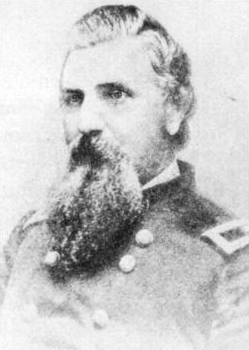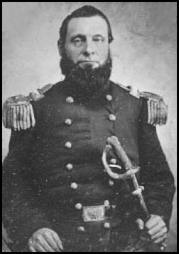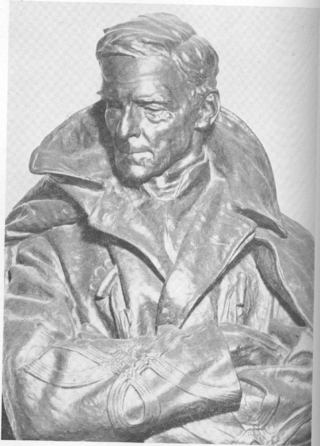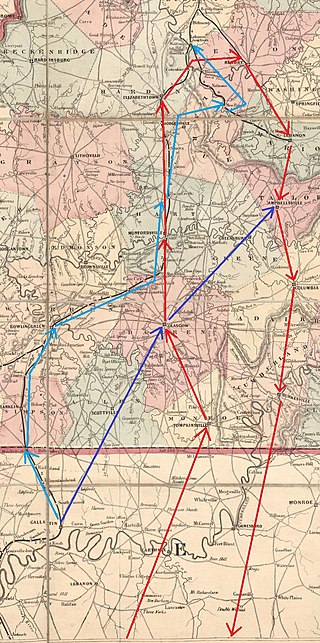
Newburgh is an incorporated town in Ohio Township, Warrick County, Indiana, United States, along the Ohio River. The population was 3,325 as of the 2010 census, although the town is part of the larger Evansville metropolitan area, which recorded a population of 342,815, and Ohio Township, which Newburgh shares with nearby Chandler, has a population of 37,749 according to the 2010 census with over 17,000 of those living in the town and adjacent areas. It is the easternmost suburb of Evansville.

John Hunt Morgan was a Confederate general in the American Civil War. In April 1862, he raised the 2nd Kentucky Cavalry Regiment, fought at Shiloh, and then launched a costly raid in Kentucky, which encouraged Braxton Bragg's invasion of that state. He also attacked General William Rosecrans's supply lines. In July 1863, he set out on a 1,000-mile raid into Indiana and Ohio, taking hundreds of prisoners. But after most of his men had been intercepted by U.S. Navy gunboats, including the USS Moose, Morgan surrendered at Salineville, Ohio, the northernmost point ever reached by uniformed Confederates. Morgan carried out the diversionary "Morgan's Raid" against orders, which gained no tactical advantage for the Confederacy while losing the regiment. Morgan escaped prison, but his credibility was so low that he was restricted to minor operations. He was killed at Greeneville, Tennessee, in September 1864. Morgan was the brother-in-law of Confederate general A. P. Hill. Various schools and a memorial are dedicated to him.

The Battle of Fort Donelson was fought from February 11–16, 1862, in the Western Theater of the American Civil War. The Union capture of the Confederate fort near the Tennessee–Kentucky border opened the Cumberland River, an important avenue for the invasion of the South. The Union's success also elevated Brig. Gen. Ulysses S. Grant from an obscure and largely unproven leader to the rank of major general, and earned him the nickname of "Unconditional Surrender" Grant.

Mahlon Dickerson Manson was a druggist, Indiana politician, and a Union general in the American Civil War.

Andrew Jackson Smith was a United States Army general during the American Civil War, rising to the command of a corps. He was most noted for his victory over Confederate General Stephen D. Lee at the Battle of Tupelo, Mississippi, on July 14, 1864.

The American Civil War saw extensive use of horse-mounted soldiers on both sides of the conflict. They were vital to both the Union Army and Confederate Army for conducting reconnaissance missions to locate the enemy and determine their strength and movement, and for screening friendly units from being discovered by the enemy's reconnaissance efforts. Other missions carried out by cavalry included raiding behind enemy lines, escorting senior officers, and carrying messages.

Abel Delos Streight was a peacetime lumber merchant and publisher, and was commissioned a United States Army / Union Army colonel in the American Civil War (1861-1865). His command precipitated a notable cavalry raid in April–May 1863, known as Streight's Raid into northern Alabama. He surrendered in Alabama in 1863 and was a prisoner of war for 10 months in the Confederate States capital of Richmond, Virginia. On March 12, 1866, his nomination for appointment to the grade of brevet brigadier general, to rank dating from March 13, 1865 was confirmed. He later became a politician, and served as a state senator in the Indiana Senate back home in the state capital of Indianapolis, Indiana for two terms.
The Battle of Salineville occurred July 26, 1863, near Salineville, Ohio, during the American Civil War. U.S. Brig. Gen. James M. Shackelford destroyed Confederate Brig. Gen. John Hunt Morgan's remaining Confederate cavalry and captured Morgan, ending Morgan's Raid. It was the northernmost military action involving an official command of the Confederate States Army.

Kentucky was a southern border state of key importance in the American Civil War. It officially declared its neutrality at the beginning of the war, but after a failed attempt by Confederate General Leonidas Polk to take the state of Kentucky for the Confederacy, the legislature petitioned the Union Army for assistance. Though the Confederacy controlled more than half of Kentucky early in the war, after early 1862 Kentucky came largely under U.S. control. In the historiography of the Civil War, Kentucky is treated primarily as a southern border state, with special attention to the social divisions during the secession crisis, invasions and raids, internal violence, sporadic guerrilla warfare, federal-state relations, the ending of slavery, and the return of Confederate veterans.

Adam Rankin "Stovepipe" Johnson was an antebellum Western frontiersman and later an officer in the Confederate States Army during the American Civil War. Johnson obtained fame leading the Newburgh Raid using a force of only about 35 men. Johnson and his men confiscated supplies and ammunition without firing a shot by deceiving Newburgh's defenders into thinking Confederate cannons surrounded the town. In reality, the "cannons" were an assemblage of a stove pipe, a charred log, and wagon wheels, forever giving Johnson the nickname of Adam "Stovepipe" Johnson. Permanently blinded during an 1864 skirmish, in 1887, Johnson founded the town of Marble Falls, Texas, which became known as "the blind man's town."

Indiana, a state in the Midwest, played an important role in supporting the Union during the American Civil War. Despite anti-war activity within the state, and southern Indiana's ancestral ties to the South, Indiana was a strong supporter of the Union. Indiana contributed approximately 210,000 Union soldiers, sailors, and marines. Indiana's soldiers served in 308 military engagements during the war; the majority of them in the western theater, between the Mississippi River and the Appalachian Mountains. Indiana's war-related deaths reached 25,028. Its state government provided funds to purchase equipment, food, and supplies for troops in the field. Indiana, an agriculturally rich state containing the fifth-highest population in the Union, was critical to the North's success due to its geographical location, large population, and agricultural production. Indiana residents, also known as Hoosiers, supplied the Union with manpower for the war effort, a railroad network and access to the Ohio River and the Great Lakes, and agricultural products such as grain and livestock. The state experienced two minor raids by Confederate forces, and one major raid in 1863, which caused a brief panic in southern portions of the state and its capital city, Indianapolis.

Camp Morton was a military training ground and a Union prisoner-of-war camp in Indianapolis, Indiana, during the American Civil War. It was named for Indiana governor Oliver Morton. Prior to the war, the site served as the fairgrounds for the Indiana State Fair. During the war, Camp Morton was initially used as a military training ground. The first Union troops arrived at the camp in April 1861. After the fall of Fort Donelson and the Battle of Shiloh, the site was converted into a prisoner-of-war camp. The first Confederate prisoners arrived at Camp Morton on February 22, 1862; its last prisoners were paroled on June 12, 1865. At the conclusion of the war, the property resumed its role as the fairgrounds for the Indiana State Fair. In 1891 the property was sold and developed into a residential neighborhood known as Morton Place, a part of the Herron-Morton Place Historic District.

Thomas Armstrong Morris was an American railroad executive and civil engineer from Kentucky and a soldier, serving as a brigadier general of the Indiana Militia in service to the Union during the early months of the American Civil War. During the Western Virginia Campaign in 1861, he played an important role in leading regiments from West Virginia, Indiana, and Ohio in clearing the Confederate army from western Virginia during the Battle of Philippi, a move that helped bolster pro-Union sentiment and contributed to the creation of the separate state of West Virginia. Morris was also instrumental in the planning and construction of the Reconstruction era Indiana State House.

Guerrilla warfare was waged during the American Civil War (1861–1865) by both sides of the conflict, but most notoriously by the Confederacy. It gathered in intensity as the war dragged.

James Murrell Shackelford was a lawyer, judge, and general in the Union Army during the American Civil War. He has the distinction of having captured Confederate cavalry commander John Hunt Morgan in mid-1863, effectively ending "Morgan's Raid".

The Colonel Richard Owen bust is a public artwork by American artist Belle Kinney Scholz and is located in the Indiana Statehouse in Indianapolis, Indiana. The bronze bust was dedicated in 1913 as a memorial to U.S. Army Colonel Richard Owen. It was funded by contributions from individuals and Confederate veteran associations in recognition of Owen's courtesy to Confederate prisoners of war while he was commandant of Camp Morton, a prison camp in Indianapolis, during the American Civil War. The bust is approximately 70 inches (180 cm) tall, 40 inches (100 cm), and 21 inches (53 cm).
The 76th Regiment Indiana Infantry was an infantry regiment that served in the Union Army during the American Civil War.

John Love was a United States Army officer during and after the Mexican-American War, a railroad contractor, an officer in the Union Army during the American Civil War and a major general in the Indiana Legion, also referred to as the Indiana militia or home guard or state defense force, during the American Civil War. After resigning on January 1, 1863, he was called back into service in July 1863 and commanded an Indiana militia force which pursued Confederate Brigadier General John Hunt Morgan's raiders in Indiana. On July 11, 1863, about 100 militia men held off Morgan's raiders at Vernon, Indiana, forcing them to withdraw when Love arrived with reinforcements arrived. After his service he was a real estate broker and representative of the Gatling Gun Company in Europe. In 1880, Congress appointed Love to be a manager of the National Home for Disabled Volunteer Soldiers.

Morgan's Christmas Raid was carried out by Confederate Brigadier General John Hunt Morgan between December 22, 1862, and January 5, 1863. Morgan intended to cut the supply lines to the Union Army of the Cumberland in Tennessee. The Union used the Louisville and Nashville Railroad, and Morgan had identified two 500-foot (150 m) long trestle bridges at Muldraugh Hill that could be burnt. Morgan's 4,000-strong cavalry force left Alexandria, Tennessee, on December 22 and passed into Kentucky on Christmas Eve, defeating part of the 2nd Michigan Cavalry Regiment near Tompkinsville. They fought and defeated an Indiana cavalry detachment on Christmas Day at Bear Wallow, Barren County. The U.S. Army sent forces under Colonel John Marshall Harlan and Major General Joseph J. Reynolds to try to catch Morgan. However, Morgan used ruses to distract his pursuers. Morgan captured a Union stockade at Bonnieville on December 26 and on December 27 captured Elizabethtown before burning the bridges at Muldraugh Hill.

The BattleofPantherCreek was fought on September 20, 1862, south of Owensboro, Kentucky. It was the only battle that took place in Daviess County, Kentucky during the American Civil War.





















